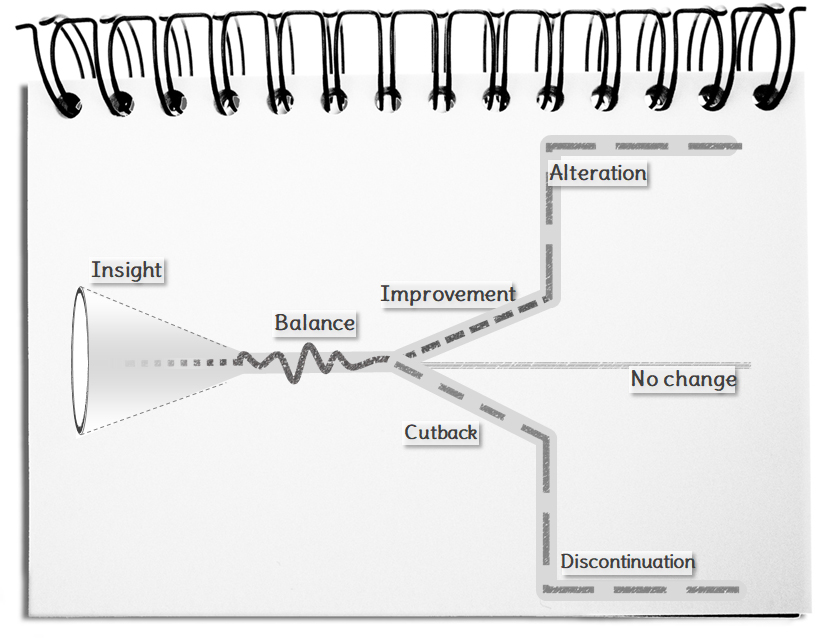When experts examine systematically, facts dissolve into incredibly subtle components, whereby our view of the whole gets lost. Thus, we see the most filigree extracts and their variability but cannot see the consequences and cope with the tasks. By looking at the details, the connections and dependencies are lost on all upper levels. In the past, additionally applied measures under the heading Change Management offered a way out. Cost and time pressure, as well as the lack of decisiveness, lead decision-makers to shy away from such supporting activities. For these reasons, it is time to reframe change. It is always – and different.
For those who think this is exaggerated, it is worth looking at the following change degrees.
- Insight
Change begins in the mind of the observer. Everything that attracts attention has somehow changed. A sensory stimulus in the context that does not match the unconscious expectations activates consciousness – an irregularity in the field of vision, an unexpected sound, a surprising gut feeling, an inappropriate smell. Mindful people respond early to stimuli of all kinds. The resulting aha-experience fuel readiness to take the initiative in teams, departments, divisions, parts of a company, and an enterprise. - Balance
Every action, no matter how small, variegates the conditions. When the current state is threatened, employees respond with fine-tuning to avoid difficulties. For this purpose, individuals have a baseline in mind to smoothen the deviations. Just like a vehicle’s cruise control maintains the desired speed, this ensures the interaction of the units. A prerequisite for stabilization is the establishing of the boundaries at which the individual units orient themselves. The deviations occur at every involved workplace. The sum of all readjustments results in a background noise that happens continuously and can surprisingly build up to a first-order change at any time and any place. - Improvement and Cutback
First-order changes are the small deviations that we prepare for or react to in the context of the traditional Continuous Improvement. Here, we are not talking about stabilization but about persistent, small changes that accumulate over a long time into extensive transformation. They can lead at best to an increase in performance and at worst to a decrease in performance. The countermeasures take care of avoiding or correcting weaknesses without questioning and changing the basic conditions and assumptions. This constant learning process, which continually improves the existing business, should also take place everywhere and always to be fit for the disruptions, the second-order changes. - Alteration and discontinuation
The second-order changes occur in the wake of societal and technological advances – when entering the machine, mobility, and information ages. The radical upheavals that have occurred question actions, services, and organizations and generate at the same time new paradigms and business models. In the meantime, hardware, software, and global networking achieve under the flag of digitalization the tasks that were predicted years ago. The impact lets disappear manual tasks in favor of intelligent robots. Even simple decisions can be automated, which results in winding-up administrative and managerial bodies. These revolutions compel at least the replacement, if not elimination, of entire units. It requires active change management, as we know it, to mitigate the staff resistance against the initiatives and thereby ensure the company’s task fulfillment. - No change
With panta rei (πάντα ῥεῖ) Heraclitus already understood 2,500 years ago that everything flows. To what extent it is the fear of change or merely the inability of those responsible that keeps them from caring about change makes no difference. The crucial factor is the tendency of decision-makers to ignore dangers. This means that inevitably arising difficulties are not prevented by taking appropriate measures and adequately preparing the employees. The enterprise’s viability needs to understand that there is no such thing as No change – take care of it.
Bottom line: The fact that we are continually changing seems to be unpleasant because the responsible people like to look away. Yet, with our activities, we initiate many changes ourselves – e.g., raw materials become products, skills become services, tasks become processes. Many deviations are not home-made, but external influences – of the customers, suppliers, competitors, the market, politics, the economic situation, the society, technology, and nature. The question is not whether a change is significant enough to deal with (see above), but only how to deal with it – no matter how big it is. This requires leadership that has rarely been taught before. Employees at all levels need to be mindful, curious, imaginative, and pro-active in mastering transformation. New Work needs this reorientation because change is always – and different.


